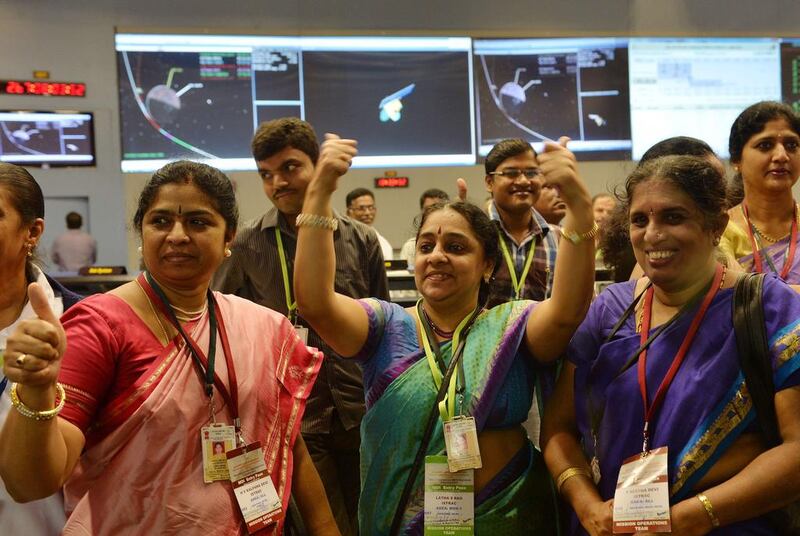To see graphic, click here
BANGALORE // India has become the first Asian country to succeed in sending a satellite into orbit around Mars at a fraction of the cost of a rival Nasa mission.
Its unmanned Mangalyaan spacecraft successfully entered the Red Planet's orbit after a 10-month journey.
India now joins an elite club of the United States, Russia and Europe who can boast of reaching Mars. More than half of all missions to the planet have ended in failure, including China’s in 2011 and Japan’s in 2003.
No single country had previously succeeded at its first go, although the European Space Agency did also succeed at its first attempt.
Scientists at mission control gave a wild cheer as the gold-coloured craft manoeuvred into the planet’s orbit at 6.32am UAE time following a 660-million kilometre voyage.
“History has been created. We have dared to reach out into the unknown and have achieved the near impossible,” a jubilant Prime Minister Narendra Modi said at the Indian Space Research Organisation’s (Isro) base near Bangalore.
“The success of our space programme is a shining symbol of what we are capable of as a nation,” Mr Modi said, grinning broadly and hugging the chairman of Isro.
The success of the mission, which is designed to search for evidence of life on the Red Planet, is a huge source of national pride for India as it competes with its Asian rivals for success in space.
India has been trying to keep up with neighbouring China, which has poured billions of dollars into its programme and plans to build a manned space station by the end of the decade.
At just US$74 million (Dh272m), the mission cost is less than the estimated $100 million budget of the sci-fi blockbuster "Gravity". That figure also represents just a fraction of the cost of Nasa's Maven spacecraft, which successfully began orbiting the fourth planet from the sun on Sunday.
Now Mangalyaan has reached Mars, the probe is expected to study the planet's surface and scan its atmosphere for methane, which could provide evidence of some sort of life form.
Mangalyaan is carrying a camera, an imaging spectrometer, a methane sensor and two other scientific instruments.
Nasa congratulated India on its "Mars arrival", welcoming Mangalyaan, which means Mars vehicle in Hindi, in a tweet to "the missions studying the Red Planet".
Indian engineers employed an unusual "slingshot" method for Mangalyaan's interplanetary journey, which began when it blasted off from India's southern spaceport on November 5 last year.
Lacking enough rocket power to blast directly out of Earth’s atmosphere and gravitational pull, it orbited the Earth for several weeks while building up enough velocity to break free.
Critics of the programme say a country that struggles to feed its people adequately and where roughly half have no toilets should not be splurging on space travel.
But supporters say it is the perfect opportunity to showcase India’s technological prowess as well as a chance for some one-upmanship on its rival Asian superpower.
“It’s a low-cost technology demonstration,” said Pallava Bagla, an author on India’s space programme.
“The rivalry between regional giants China and India exists in space too and this gives India the opportunity to inch ahead of China [and capture more of the market],” Mr Bagla said.
The decision to launch the mission was announced in a speech on Independence Day 2012, shortly after China’s attempt flopped when it failed to leave Earth’s atmosphere.
India has so far launched 40 satellites for foreign countries, since kick-starting its space programme five decades ago. But China launches bigger satellites.
Isro scientists said the Mars Orbiter Mission or MOM had “demonstrated and proved” India’s “technological capabilities” and showed it was capable of venturing further.
“MOM is a major step towards our future missions in interplanetary space,” said Isro chairman K Radhakrishnan.
The probe is expected to circle Mars for six months, about 500km from its surface.
* Agence France-Presse





